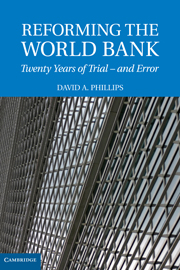Book contents
- Frontmatter
- Contents
- Preface: The Search for Effectiveness in the World's Premier Development Institution
- REFORMING THE WORLD BANK
- PART I ORIGINS AND EVOLUTION
- PART II THE SEARCH FOR EFFECTIVENESS
- PART III TOWARDS REAL REFORM: THE GOVERNANCE AGENDA
- 10 The Governors and the Directors
- 11 The Leadership
- 12 Looking Back and Looking Forward: What Is to Be Done?
- Index
11 - The Leadership
Published online by Cambridge University Press: 25 January 2011
- Frontmatter
- Contents
- Preface: The Search for Effectiveness in the World's Premier Development Institution
- REFORMING THE WORLD BANK
- PART I ORIGINS AND EVOLUTION
- PART II THE SEARCH FOR EFFECTIVENESS
- PART III TOWARDS REAL REFORM: THE GOVERNANCE AGENDA
- 10 The Governors and the Directors
- 11 The Leadership
- 12 Looking Back and Looking Forward: What Is to Be Done?
- Index
Summary
THE LEADER AND HIS LIEUTENANTS
The Strategic Compact was an agreement between the executive directors and the president. The president was not only the key figure during the reorganization but also, of course, as chief executive, important to the institution in the longer run. The president's character, style, and capacities would normally be critical to the direction and effectiveness of an institution even if the institutional persona changed only slowly. However, since the chief executive was signatory to the Strategic Compact, the characteristics of the chief executive's position – its style, qualifications, responsibilities, fiduciary duties, reporting, performance, and selection – were, unsurprisingly, not part of the Compact or the subsequent reform process. Yet one particular aspect of leadership, the selection process, was increasingly in question.
Whereas in performing their role several of the past presidents, such as Clausen and Preston, had been relatively distant figures, and had shaped the culture and functioning of the Bank rather by default, Wolfensohn took an aggressive and proactive stance. His demeanor reflected an unusual background. While he had strong Wall Street connections, he also regarded himself as having capacities beyond Wall Street. He was a lawyer and Harvard MBA and had excelled in the corporate finance world, where he led the first Chrysler rescue, and latterly he set up his own boutique investment firm that had attracted the participation of world-class individuals such as Paul Volcker.
- Type
- Chapter
- Information
- Reforming the World BankTwenty Years of Trial - and Error, pp. 263 - 279Publisher: Cambridge University PressPrint publication year: 2009

